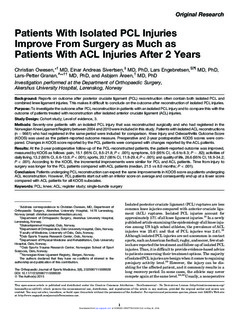| dc.contributor.author | Owesen, Christian | |
| dc.contributor.author | Sivertsen, Einar Andreas | |
| dc.contributor.author | Engebretsen, Lars | |
| dc.contributor.author | Granan, Lars-Petter | |
| dc.contributor.author | Årøen, Asbjørn | |
| dc.date.accessioned | 2016-05-25T12:23:21Z | |
| dc.date.available | 2016-05-25T12:23:21Z | |
| dc.date.issued | 2015-08-19 | |
| dc.identifier.citation | The Orthopaedic Journal of Sports Medicine. 2015, 3, 8 | nb_NO |
| dc.identifier.uri | http://hdl.handle.net/11250/2390410 | |
| dc.description | This article is distributed under the terms of the Creative Commons Attribution-NonCommercial-NoDerivs 3.0 License (http://www.creativecommons.org/licenses/by-nc-nd/3.0/) which permits non-commercial use, reproduction and distribution of the work as published without adaptation or alteration, without further permission provided the original work is attributed as specified on the SAGE and Open Access page (https://us.sagepub.com/en-us/nam/open-access-at-sage). | nb_NO |
| dc.description.abstract | Background: Reports on outcome after posterior cruciate ligament (PCL) reconstruction often contain both isolated PCL and combined knee ligament injuries. This makes it difficult to conclude on the outcome after reconstruction of isolated PCL injuries.
Purpose: To investigate the outcome after PCL reconstruction in patients with an isolated PCL injury and to compare this with the outcome of patients treated with reconstruction after isolated anterior cruciate ligament (ACL) injuries.
Study Design: Cohort study; Level of evidence, 3.
Methods: Seventy-one patients with an isolated PCL injury that was reconstructed surgically and who had registered in the Norwegian Knee Ligament Registry between 2004 and 2010 were included in this study. Patients with isolated ACL reconstructions (n = 9661) who had registered in the same period were included for comparison. Knee Injury and Osteoarthritis Outcome Score (KOOS) was used as the patient-reported outcome measure. Preoperative and 2-year postoperative KOOS scores were compared. Changes in KOOS score reported by the PCL patients were compared with changes reported by the ACL patients.
Results: At the 2-year postoperative follow-up of the PCL-reconstructed patients, the patient-reported outcome was improved, measured by KOOS as follows: pain, 15.1 (95% CI, 8.5-21.8; P < .001); symptoms, 0.9 (95% CI, –6.6 to 8.3; P = .82); activities of daily living, 13.2 (95% CI, 6.6-13.9; P < .001); sports, 20.7 (95% CI, 11.8-29.4; P < .001); and quality of life, 26.6 (95% CI, 18.9-34.2; P < .001). According to the KOOS, the incremental improvements were similar for PCL and ACL patients. Time from injury to surgery was longer for the PCL patients compared with ACL patients (median, 21.5 vs 8.0 months; P < .001).
Conclusion: Patients undergoing PCL reconstruction can expect the same improvements in KOOS score as patients undergoing ACL reconstruction. However, PCL patients start out with an inferior score on average and consequently end up at a lower score compared with ACL patients for all KOOS subscales. | nb_NO |
| dc.language.iso | eng | nb_NO |
| dc.publisher | Sage | nb_NO |
| dc.subject | PCL | nb_NO |
| dc.subject | ACL | nb_NO |
| dc.subject | knee | nb_NO |
| dc.subject | register study | nb_NO |
| dc.subject | single-bundle surgery | nb_NO |
| dc.title | Patients with isolated PCL injuries improve from surgery as much as patients with ACL injuries after 2 years. | nb_NO |
| dc.type | Journal article | nb_NO |
| dc.type | Peer reviewed | nb_NO |
| dc.subject.nsi | VDP::Medical disciplines: 700 | nb_NO |
| dc.subject.nsi | VDP::Medical disciplines: 700::Sports medicine: 850 | nb_NO |
| dc.source.journal | Orthopaedic Journal of Sports Medicine (OJSM) | nb_NO |
| dc.description.localcode | Seksjon for kroppsøving og pedagogikk / Department for Physical Education | nb_NO |
